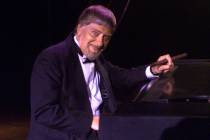Book recounts history of actors union
Since The Smith Center for the Performing Arts has begun bringing Las Vegas plenty of union touring shows, local audiences and performers have been sharing with me their strong opinions about Equity versus non-Equity productions. Anti-union folks won't find much comfort in Robert Simonson's just released coffee-table book "Performance of the Century: 100 Years of Actors Equity Association and the Rise of Professional American Theater."
As expected, the salute is a one-sided interpretation of the benefits of union membership. But it's a fascinating, entertaining look at how and why the organization came to be.
Maybe the most riveting section deals with the strike of 1919, which made Equity a force to be reckoned with. Professional playhouses were apparently not kind to the lowly actor. It was common to rehearse anywhere from six to 16 weeks with no pay. And if the director decided to replace a performer just before opening night, the thespian received no compensation of any kind. If the show closed while on tour, the moneymen were under no obligation to get their employees back home.
It was obvious something needed to be done. Curiously, though, many theater folks were against the idea of forming an organization. "Unions are for tradespeople," some said, "and we are not tradespeople. We are artists."
But even artists have to eat, and, according to the book, the abuse grew so rampant that even wealthy stars - such as Oscar-winner Marie Dressler - helped shut down Broadway and road companies until minimum demands were met.
The book abounds with humorous tales. Legendary comic Ed Wynn wasn't able to perform at a union benefit because he was appearing in a production whose producers had won an injunction forbidding him to take the stage. Simple solution: He arranged for a spotlight to hit him in the audience and said, "Ladies and gentlemen, Justice Lyndon has forbidden me to appear on the stage tonight ... and of course the orders of the court must be obeyed. If I had been able to appear tonight, I had in mind telling you a story." He then did his entire act from his audience seat.
The battles on both sides were fought by many well-known artists. Perhaps the person who came out the most scathed was George M. Cohan, who seemed to consider the formation of a union a personal affront.
Simonson also recounts Equity's slow efforts to establish a pension plan (which brought about the 1960 strike), deal with racial discrimination (as in Vegas, black performers on the road were rarely permitted to stay in the same hotel as their white colleagues), the reactions to the AIDS crisis (which, before people knew much about it, was taking the lives of members of literally every major Broadway show), the days after Sept. 11, 2001, (when The Great White Way was dark until the mayor asked producers to get their shows back on the boards, for the public's sake) and the current compromises Equity has had to make to accommodate the many touring outfits that have chosen not to go union (some of which have played and will continue to play The Smith Center).
The book comes complete with multiple photos of yesteryear and today, along with advice from many in-demand current working actors and techies. It's a fun read for buffs. And a history of Equity is, after all, a history of modern American theater.
(Next installment: Some of that great advice in the book from those in-demand pros.)
Anthony Del Valle can be reached at
vegastheaterchat@aol.com. You can write him c/o Las Vegas Review-Journal, P.O. Box 70, Las Vegas, NV 89125.























